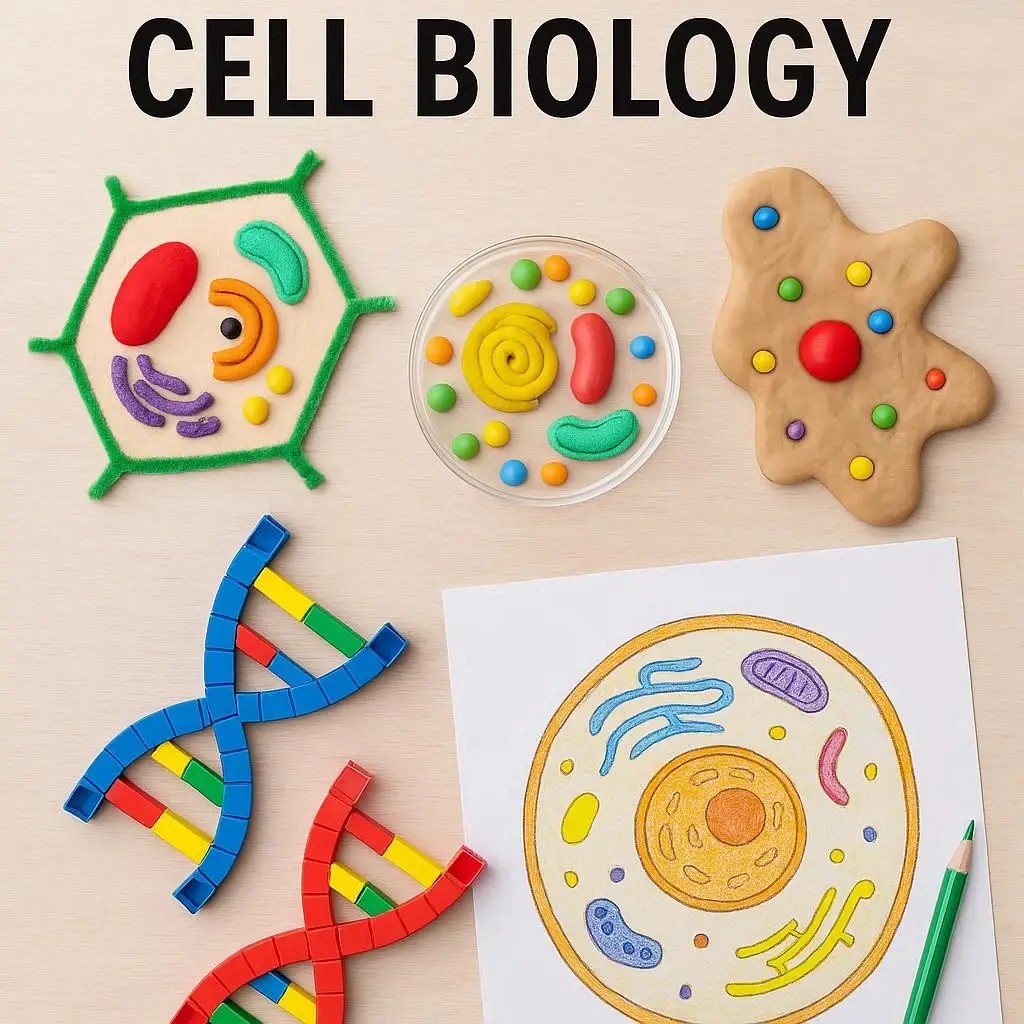Where can I find hands-on activities for teaching cell biology?
Where to Find Great Hands-On Cell Biology Activities
1. Interactive & Virtual Resources
Labster’s Cell Structure Virtual Lab
An immersive interactive simulation that guides students through exploring cell organelles, structures, and their functions virtually. Great for visual and kinesthetic learners. Labster“Amazing Cells” by Teach Genetics (University of Utah)
Offers multimedia tools like the Virtual Microscope and Inside a Cell, which allow students to zoom in from tissues to organelles in a dynamic, layered learning experience. teach.genetics.utah.eduExploratorium's Digital Teaching Box – Cell Biology
A curated high school lesson pack with digital and hands-on materials, ideal for building an engaging three-week unit on cell biology. ExploratoriumBioMan Cell Explorer & Lawrence Hall of Science Simulations
Interactive games and virtual lab activities that let students build and explore plant and animal cell models through gameplay. TCEA TechNotes Blog
2. Creative Classroom Activities
Cell Organelle Speed Dating
Students use cards representing different organelles and “speed date” to match functions—fast-paced and interactive. thetropicalscienceteacher.comTransform Your Classroom into a Cell
As shared by educators on Reddit:“Turn the room into a cell. Have kids walk the path of certain processes, like protein synthesis.”
“I have my kids make 3-d cells … out of almost anything—Lego, styrofoam, bake a cake… They LOVE it.” RedditPrintable Packs & Notebook Projects
Editable packs for animal and plant cells, plus interactive notebook activities, ideal for both guided and independent projects. Weird, Unsocialized HomeschoolersElementary-Level Craftivity
Activities such as labeled cell diagram models, team debates on cell types, and interactive microscope modules make learning exploratory and collaborative. The Owl Teacher
3. Edible and Model-Based Learning
Edible Cell Models
Cell Cake: Use cake and frosting as the cell body, with candies representing organelles.
Pizza Cell: Toppings symbolize different cell parts.
Jello Cell: Jello base with candy organelles—a fun, edible 3D diagram. You ARE an ARTiST!Weird, Unsocialized Homeschoolers
Slime Cell Models
Using colored slime to simulate cytoplasm, and household items (glitter, gems, bouncy balls, etc.) to represent organelles in both animal and plant cells. Weird, Unsocialized Homeschoolers
4. Educational Games & Board Games
Cytosis – A Cell Biology Board Game
A strategy-based worker-placement board game that replicates cellular processes like protein synthesis. It’s immersive, scientifically themed, and endorsed by the Journal of Cell Science.Genomics Digital Lab (by Spongelab Interactive)
A browser-based game series that takes students through levels inside organelles—chloroplasts, mitochondria, and the nucleus—with mini-games for photosynthesis, energy conversion, transcription, and translation.
Quick Reference Table
| Type of Activity | Examples & Platforms | Best For |
|---|---|---|
| Virtual Simulations | Labster, Virtual Microscope, Exploratorium | Visual, interactive learners |
| Classroom Roleplay & Crafts | Tissue-to-cell room, Speed Dating, Models | Group engagement & creativity |
| Edible Models | Cake, Jello, Pizza, Slime Cells | Multi-sensory, memorable learning |
| Printable Worksheets | Cell packs, notebook craftivity | Structured and guided learning |
| Educational Games | Cytosis board game, Genomics Digital Lab | Game-based, strategic thinking |
Where to Start?
For tech-savvy environments: try Labster or BioMan Explorer for interactive simulations.
In-relatable, tactile classrooms: go with edible/slime models or 3D builds.
Looking for structured lesson plans? Use Exploratorium’s Digital Teaching Box or the Printable Cell Packs.
To boost critical thinking and systems understanding, Cytosis or Genomics Digital Lab offer strategic gameplay with learning built in.
Sources for Hands-On Cell Biology Activities
Hands-on activities are a fantastic way to make cell biology concepts come to life for students. You can find excellent resources from a variety of places, from educational websites to science supply companies. Websites like PBS LearningMedia and BioInteractive (from the Howard Hughes Medical Institute) offer a wealth of free, high-quality resources including virtual labs, interactive simulations, and downloadable lesson plans. Another great source is scientific supply companies like Carolina Biological and Fisher Scientific, which often have dedicated educational sections on their websites with free lab protocols and teaching guides. Don't forget to check with local universities or science museums, as they sometimes have outreach programs or lending kits available for educators.
Classroom Experiments for Cell Biology
Classroom experiments don't have to be complex or expensive to be effective. A classic and simple experiment is the onion and cheek cell lab, where students prepare and observe their own cells under a microscope. This activity directly teaches the differences between plant and animal cells. Another great one is the osmosis and diffusion lab using a potato or an egg. By placing potato slices or a de-shelled egg in different solutions (like salt water or plain water), students can directly observe how water moves across a semipermeable membrane. For a look at cell processes, a yeast fermentation experiment is a fun and easy way to demonstrate cellular respiration. You can simply use yeast, sugar, and warm water in a bottle with a balloon on top to watch the balloon inflate from the carbon dioxide gas produced.
Online Resources and Kits for Students
When in-person labs aren't possible or you want to supplement your curriculum, online resources and ready-made kits are invaluable. Websites like LabXchange from Harvard University offer virtual lab environments where students can perform experiments and explore concepts in a safe, digital space. PHET Interactive Simulations from the University of Colorado Boulder provides free, interactive simulations that allow students to manipulate variables and visualize cellular processes like mitosis or photosynthesis. If you're looking for physical materials, many companies sell classroom kits that come with all the necessary supplies and instructions for a particular lab, such as DNA extraction from strawberries or creating DNA models. These kits are convenient and ensure you have everything you need to conduct the activity successfully.
Tips for Safe and Effective Lab Activities
Safety is the top priority in any science classroom. Always begin a new lab activity by reviewing safety protocols with your students. This includes wearing appropriate personal protective equipment (PPE) like safety goggles, handling chemicals with care, and knowing the location of safety equipment like eyewash stations and fire extinguishers. Beyond safety, an effective lab should have clear, step-by-step instructions. You can use visual aids like diagrams or videos to help students understand the procedure. Encourage students to work in small groups to promote collaboration and discussion. Finally, make sure to provide time for post-lab reflection and analysis. This helps students connect their observations to the underlying biological principles.
Assessing Learning Through Hands-On Projects
Assessing student learning from hands-on projects goes beyond a simple lab report. You can use a variety of methods to gauge understanding. One effective approach is to have students create a lab notebook where they document their hypothesis, procedure, observations, and conclusions. This encourages careful scientific documentation. You could also have them present their findings to the class or create a poster or infographic summarizing their experiment. Another option is a summative assessment, such as a short answer or essay question, where students have to explain the scientific principles they observed during the activity. For example, after the osmosis lab, you could ask them to explain why the potato slices changed in weight based on the concentration of the solution. This ensures they've moved beyond just following instructions to truly understanding the concepts.













